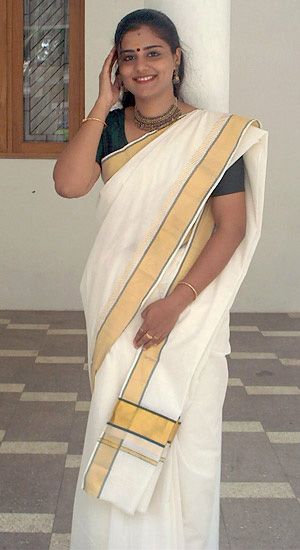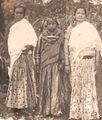ساري (زي)
الساري Sari [note 1] هو زي نسائي هندي، يتكون من شريط طويل من القماش غير المخاط يمكن لفه بعدّة أساليب، أكثر الأساليب إنتشارا يتم بلفه حول الخصر ثم رفع إحدى النهايات فوق الكتف.
أصل الاسم
The word sari described in Sanskrit शाटी śāṭī[1] which means 'strip of cloth'[2] and शाडी śāḍī or साडी sāḍī in Pali, and which evolved to sāṛī in modern Indian languages.[3] The word 'Sattika' is mentioned as describing women's attire in ancient India in Sanskrit literature and Buddhist literature called Jatakas.[4] This could be equivalent to modern day 'Sari'.[4] The term for female bodice, the choli evolved from ancient Stanapatta.[5][6] Rajatarangini (meaning the 'river of kings'), a tenth-century literary work by Kalhana, states that the choli from the Deccan was introduced under the royal order in Kashmir.[7]
الأصول والتاريخ
أنماط الإسدال

صور تاريخية وأنماط إقليمية
Women in choli (blouse) and antariya CE 320 Gupta Empire.
Kalpasutra manuscript c. 1375 CE.
Green Tara depicted with sari, c. 11th century CE.
Kandyan Sinhalese lady wearing a traditional Kandyan sari (osaria).
Girl in pochampally sari, 1895 CE.
Women in nauvari sari.
Woman in nivi sari & vaddanam.
نمط نيڤي
Professional style of draping

Bangladesh
Shari (بالبنغالية: শাড়ি) is the national wear of Bangladeshi women. Most women who are married wear sharee as their regular dress while young-unmarried girls wear sharee as an occasional dress.
Sri Lanka
Sri Lankan women wear saris in many styles. Two ways of draping the sari are popular and tend to dominate: the Indian style (classic nivi drape) and the Kandyan style (or osaria in Sinhala). The Kandyan style is generally more popular in the hill country region of Kandy from which the style gets its name. Though local preferences play a role, most women decide on style depending on personal preference or what is perceived to be most flattering for their figure.
Nepal
The sari is the most commonly worn women's clothing in Nepal where a special style of sari draping is called haku patasihh. The sari is draped around the waist and a shawl is worn covering the upper half of the sari, which is used in place of a pallu.
Pakistan
In Pakistan, the saris are still popular and worn on special occasions. The Shalwar kameez, however, is worn throughout the country on a daily basis. The sari nevertheless remains a popular garment among the middle and upper class for many formal functions. Saris can be seen worn commonly in metropolitan cities such as Karachi and Islamabad and are worn regularly for weddings and other business types of functions. Saris are also worn by many Muslim women in Sindh to show their status or to enhance their beauty. [8] The sari is worn as daily wear by Pakistani Hindus, by elderly Muslim women who were used to wearing it in pre-partition India[9] and by some of the new generation who have reintroduced the interest in saris.[بحاجة لمصدر]
Similarities with other Asian clothing
While the sari is typical to traditional wear for women in the Indian subcontinent, clothing worn by women in Southeast Asian countries like Myanmar, Malaysia, the Philippines, Cambodia, Thailand and Laos resemble it, where a long rectangular piece of cloth is draped around the body. These are different from the sari as they are wrapped around the lower-half of body as a skirt, worn with a shirt/blouse and resemble a sarong, as seen in the Burmese Longyi, Filipino Malong and Tapis, Laotian Xout lao and Suea pat, Thai Sbai and Sinh, Cambodian Sampot and Timorese Tais. Saris, worn predominantly in the Indian subcontinent are usually draped with one end of the cloth fastened around the waist, and the other end placed over the shoulder baring the midriff.[10][11][12]
Ornamentation and decorative accessories

Saris are woven with one plain end (the end that is concealed inside the wrap), two long decorative borders running the length of the sari, and a one to three-foot section at the other end which continues and elaborates the length-wise decoration. This end is called the pallu; it is the part thrown over the shoulder in the nivi style of draping.
Sari outside the Indian subcontinent
صور
Galaxy of Musicians by Raja Ravi Varma depicting women in various styles of sari.
Style of sari worn in Coorg.
Sinhalese woman wearing a traditional Kandyan sari (osaria).
انظر أيضاً
للاستزادة
- Shraddha Goled (21 July 2019). "#SareeTwitter: Saree As A Tool Of Revolution, Power & Politics". The Logical Indian (in الإنجليزية).
ملاحظات
- ^ The name of the garment in various regional languages include:
بالبنغالية: শাড়ি śāṛi, هندي: साड़ी قالب:AST, بالاوريا: ଶାଢୀ, sāddhi, گجراتي: સાડી, sāḍī, بالكنادا: ಸೀರೆ, sīrē, قالب:Lang-knn, sāḍī, kāpaḍ, cīrē, مليالم: സാരി sāri, بالماراثية: साडी sāḍī, نـِپالي: सारी sārī, بالپنجابي: ਸਾਰੀ sārī, بالتاميل: புடவை puṭavai, بالتلوگو: చీర cīra, أردو: ساڑى sāṛī
المراجع
- ^ R. S. McGregor, ed. (1997). The Oxford Hindi-English Dictionary. Oxford University Press. p. 1003. ISBN 978-0-19-864339-5.
- ^ Monier-Williams, Monier (1995). A Sanskrit-English Dictionary. Delhi: Motilal Banarsidass. p. 1063. ISBN 978-81-208-0065-6. Retrieved 4 July 2010.
- ^ Kapoor, Subodh (2002). The Indian encyclopaedia: biographical, historical, religious, administrative, ethnological, commercial and scientific. Reunion-Satya Yauvana, Volume 20. Genesis Publishing Pvt Ltd. p. 6422 (pg no. starts from 6130). ISBN 978-81-7755-257-7.
The etymology of the word sari is from the Sanskrit 'sati', which means strip of cloth. This evolved into the Prakriti 'sadi', and was later anglicised into sari
- ^ أ ب Sachidanand, Sahay (1975) Indian costume, coiffure, and ornament. Chapter 2 'Female Dress', Munshiram Manoharlal publishers Pvt Ltd. pp 31–55
- ^ Prachya Pratibha, 1978 "Prachya Pratibha, Volume 6", p.121
- ^ Agam Kala Prakashan, 1991 "Costume, coiffure, and ornaments in the temple sculpture of northern Andhra", p.118
- ^ خطأ استشهاد: وسم
<ref>غير صحيح؛ لا نص تم توفيره للمراجع المسماةVijay Singh Katiyar - ^ "Bollywood, saris and a bombed train". Asia Times. Retrieved 31 August 2007.
- ^ "The spread of the salwar". The Hindu. Chennai, India. 24 October 2004. Retrieved 31 August 2007.
- ^ خطأ استشهاد: وسم
<ref>غير صحيح؛ لا نص تم توفيره للمراجع المسماةalkazi - ^ خطأ استشهاد: وسم
<ref>غير صحيح؛ لا نص تم توفيره للمراجع المسماةBoulanger - ^ خطأ استشهاد: وسم
<ref>غير صحيح؛ لا نص تم توفيره للمراجع المسماةGhurye
Bibliography
- Ambrose, Kay (1950) Classical Dances and Costumes of India. London: A. & C. Black.
- Craddock, Norma (1994) Anthills, Split Mothers, and Sacrifice: Conceptions of Female Power in the Mariyamman Tradition. Dissertation, University of California, Berkeley.
وصلات خارجية
- Articles containing بنغالي-language text
- Articles containing هندي-language text
- Articles containing Odia-language text
- Articles containing گجراتي-language text
- Pages using Lang-xx templates
- Articles containing كنادا-language text
- Articles containing ملايالم-language text
- Articles containing مراثي-language text
- Articles containing Nepali (macrolanguage)-language text
- Articles containing Punjabi-language text
- Articles containing تاميلية-language text
- Articles containing تلوگو-language text
- Articles containing أردو-language text
- Articles with unsourced statements from August 2017
- Saris
- Dresses
- Indian clothing
- Nepalese clothing
- Bangladeshi clothing
- Pakistani clothing
- History of Asian clothing
- History of fashion
- Sri Lankan clothing
- ملابس
- الهند











































